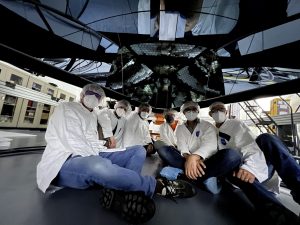 On June 2, the second module of the RICH detector (Ring Imaging Cherenkov) was installed in the CLAS12 spectrometer at the Jefferson Laboratory in the USA. This marked the completion of an adventure lasting more than 10 years, which started in 2011 when the physicists of the Frascati National Laboratories proposed the construction of a detector allowing the identification, in energy zones not otherwise accessible, of particles with the “strange” quark s (K mesons). This to permit the CLAS12 experiment to broaden the research field on the structure of the nucleon and the role that quarks and gluons play in it.
On June 2, the second module of the RICH detector (Ring Imaging Cherenkov) was installed in the CLAS12 spectrometer at the Jefferson Laboratory in the USA. This marked the completion of an adventure lasting more than 10 years, which started in 2011 when the physicists of the Frascati National Laboratories proposed the construction of a detector allowing the identification, in energy zones not otherwise accessible, of particles with the “strange” quark s (K mesons). This to permit the CLAS12 experiment to broaden the research field on the structure of the nucleon and the role that quarks and gluons play in it.
The detector exploits the Cherenkov effect, namely the highly directional light emission generated by particles that propagate in a transparent medium with a speed that is greater than that light has in this material. Particles of different speeds emit Cherenkov light in a cone of different angular aperture, and therefore the measurement of the emission angle allows to measure their speed and, ultimately, to identify them.
Each module is composed of a Cherenkov light radiator consisting of 102 20×20 cm2 aerogel tiles, a complex system of 7 flat mirrors and 10 spherical mirrors covering a total area of approximately 10 m2, and 391 multianode photomultipliers for a total of 25,000 independent channels.
Numerous INFN sections, the Jefferson Laboratory and various European and American research institutions also contributed to the construction of the detector.
The first RICH module, installed in January 2018, contributed to the success of the data taking of the CLAS12 experiment with the new electron beam of 12 GeV energy characterized by high brightness and polarization degree. Due to the delays caused by the pandemic, the assembly of the second module began in clean room only in January 2022 and lasted until May. On June 1st, the detector was transported to the experimental hall and the next day the installation in CLAS12 took place, to be ready for the data taking with polarized targets.
A few days after its installation, the second module of the RICH is now fully operational together with its twin.
 INFN-LNF Laboratori Nazionali di Frascati
INFN-LNF Laboratori Nazionali di Frascati